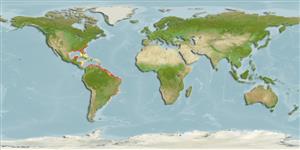Preferred temperature (Ref.
115969): 22.5 - 27.7, mean 24.9 (based on 288 cells).
Índice de diversidade filogenética (Ref.
82804): PD
50 = 0.5020 [Uniqueness, from 0.5 = low to 2.0 = high].
Bayesian length-weight: a=0.00794 (0.00499 - 0.01264), b=3.05 (2.92 - 3.18), in cm Total Length, based on LWR estimates for this species & (Sub)family-body (Ref.
93245).
Nível Trófico (Ref.
69278): 3.9 ±0.6 se; based on diet studies.
Resiliência (Ref.
120179): médio(a), tempo mínimo de duplicação da população 1,4 - 4,4 anos (Assuming tm <4).
Prior r = 0.53, 95% CL = 0.35 - 0.80, Based on 1 data-limited stock assessment.
Fishing Vulnerability (Ref.
59153): Moderate vulnerability (38 of 100).
Climate Vulnerability (Ref.
125649): High vulnerability (56 of 100).
